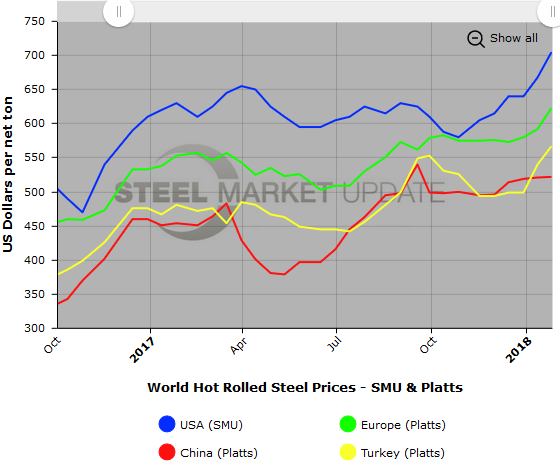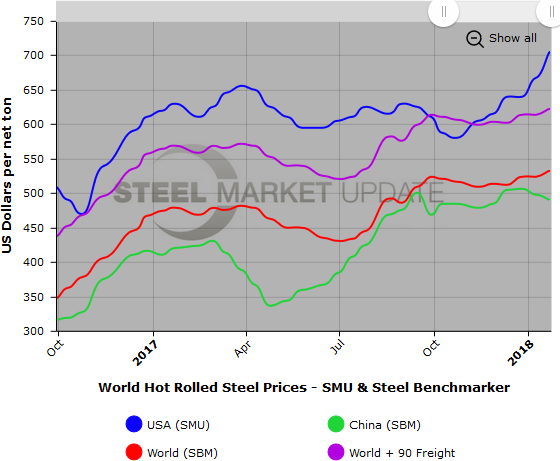International Steel Prices

Foreign vs. Domestic Hot Rolled Price Comparison
Written by Brett Linton
January 25, 2018
The following calculation is used by Steel Market Update to identify the theoretical spread between foreign hot rolled steel import prices (delivered to USA ports) and domestic (USA) hot rolled coil prices (FOB Domestic mills). We want our readers to be aware that this is only a “theoretical” calculation as freight costs, trader margin and other costs can fluctuate, ultimately influencing the true market spread.
Our primary numbers for this analysis are from Platts as we compare European HRC export pricing (FOB Ruhr), Turkey HRC export pricing (FOB Turkey) and Chinese HRC export pricing (FOB Chinese port). Be aware that Chinese hot rolled pricing is not available to the U.S. market, so the Chinese spread is nothing more than an exercise in “what if.” SteelBenchmarker is the secondary data provider of foreign hot rolled coil prices and is noted further down in this article.
![]() SMU adds $90 per ton to these foreign prices taking into consideration freight costs, handling, trader margin, etc. This provides an approximate “CIF U.S. ports price” that can then be compared against the SMU U.S. hot rolled price average (FOB Mill), with the result being the spread (difference) between domestic and foreign hot rolled prices. As the price spread narrows, the competitiveness of imported steel into the United States is reduced. If the spread widens, then foreign steel becomes more attractive to U.S. flat rolled steel buyers. A positive spread means U.S. prices are theoretically higher than foreign prices, while a negative spread means U.S. prices are less than foreign prices.
SMU adds $90 per ton to these foreign prices taking into consideration freight costs, handling, trader margin, etc. This provides an approximate “CIF U.S. ports price” that can then be compared against the SMU U.S. hot rolled price average (FOB Mill), with the result being the spread (difference) between domestic and foreign hot rolled prices. As the price spread narrows, the competitiveness of imported steel into the United States is reduced. If the spread widens, then foreign steel becomes more attractive to U.S. flat rolled steel buyers. A positive spread means U.S. prices are theoretically higher than foreign prices, while a negative spread means U.S. prices are less than foreign prices.
As of Thursday, Jan. 25, Platts’ published European HRC prices were at $623 per net ton FOB Ruhr ($551 euros per metric ton), up $31 from two weeks ago and up $43 from late-December. Adding in $90 per ton for import costs, that puts the price at $713 per net ton from Europe delivered to the U.S. The latest Steel Market Update hot rolled price average is $705 per ton for domestic steel, up $37 per ton from two weeks ago and up $65 from late-December. This puts the theoretical spread between European and U.S. HR prices at -$8 per ton, down compared to both the -$14 spread calculated two weeks ago and the -$30 spread one month ago. This means that U.S.-sourced HR is now theoretically $8 per ton cheaper than getting HR steel imported from Europe. Although this price spread is not as attractive to U.S. steel buyers as the spreads seen in the past few months, it remains advantageous for steel buyers to continue to pursue domestic sourcing options.
Chinese HRC prices were reported by Platts as being $522 per net ton ($575 per metric ton), up $1 from two weeks ago, and up $3 from one month ago. Adding $90 in estimated import costs puts Chinese HRC prices at $612 per ton delivered (if Chinese mills were able to ship to the United States, which they are not). The theoretical spread between the Chinese and U.S. HR price is +$93 per ton, up from +$57 per ton two weeks ago, and up from +$31 per ton one month ago. Meaning that if Chinese mills were able to ship HR to the U.S., it would theoretically cost $93 per ton less than buying domestic steel.
Platts published Turkish export prices at $567 per net ton FOB Turkish port ($625 per metric ton), up $27 from two weeks ago and up $68 from one month ago. Adding $90 in import costs, the Turkish HRC “to the U.S. ports” price is $657 per ton. This puts the theoretical spread between the Turkish and U.S. HR price at +$48 per ton, up from +$38 two weeks ago, but down from +$51 one month ago. This means that HR from the U.S. is theoretically $48 per ton more expensive than importing it from Turkey. The Turkey/U.S. price spread has reversed since September/October 2017 when it dropped down to -$36 per ton (meaning domestic HR was $36 per ton cheaper than importing Turkish HR).
Freight is an important part of the final determination on whether to import foreign steel or buy from a domestic mill supplier. Domestic prices are referenced as FOB the producing mill, while foreign prices are FOB the Port (Houston, NOLA, Savannah, Los Angeles, Camden, etc.). Inland freight, from either a domestic mill or from the port, can dramatically impact the competitiveness of both domestic and foreign steel. When considering lead times, a buyer must take into consideration the momentum of pricing both domestically and in the world markets. If U.S. prices are rising, which they are at this time, thus the shrinkage in the spreads, then one must consider when the steel is to be delivered versus what is available at a firm price from foreign sources. In most circumstances (but not all), domestic steel will deliver faster than foreign steel ordered on the same day.
Below is a graph comparing the Platts foreign HR export prices against the SMU domestic HR average price. You will need to view the graph on our website to use its interactive features; you can do so by clicking here. If you need assistance with either logging in or navigating the website, please contact us at 800-432-3475 or info@SteelMarketUpdate.com
SteelBenchmarker World Export Price
The SteelBenchmarker world export price for hot rolled bands is $532 per net ton ($586 per metric ton) FOB the port of export, according to data released by SteelBenchmarker on Monday, Jan. 22. This is up $8 from both two weeks ago and one month ago. Adding in $90 in estimated import costs, that puts prices around $622 per ton delivered to the U.S. As previously mentioned, the Steel Market Update hot rolled price average this week is $705 per ton.
Therefore, the theoretical spread between the SteelBenchmarker world HR export price and the SMU HR price is +$83 per ton, meaning foreign HRC imported into the U.S. is theoretically now $83 per ton less expensive than steel purchased domestically.
The +$83 spread is $50-65 per ton higher than the average spread seen over the last few months. In late-October 2017, the spread was the lowest seen in 2017. This time last year the spread was +$61 per ton and remained steady through February, then rose to the $70-90 range over the summer months. The record high in our seven-year history was +$210 on June 27, 2016 (meaning domestic steel was theoretically $210 per ton more expensive than foreign steel), while the record low was -$70 in August 2011. The average spread for 2018 so far is +$69 per ton, while the average spread for 2017 was +$48 per ton.
We want to again remind our readers that the calculations shown above are “theoretical,” but in most markets are probably a good indicator of where you can expect to find offers being made.
Below is a graph comparing SteelBenchmarker world HR export prices against the SMU domestic HR average price. We also have included a line with the world price including freight and traders’ costs, which gives you a better indication of the true price spread. You will need to view the graph on our website to use its interactive features; you can do so by clicking here.

Brett Linton
Read more from Brett LintonLatest in International Steel Prices

US and offshore HRC prices tick lower
The threat of tariffs over the past two months has been a springboard for US prices. But the Section 232 reinstatement on March 13 narrowed the domestic premium over imports on a landed basis.

Domestic CRC prices surge ahead of imports
The price spread between stateside-produced CR and imports reached its widest margin in over a year.

US HR prices rising faster than offshore tags
Hot-rolled (HR) coil prices continued to rally in the US this week, quickly outpacing price gains seen abroad. The result: US hot band prices have grown widely more expensive than imports on a landed basis. The premium US HR tags carry over HR prices abroad now stands at a 14-month high. SMU’s average domestic HR […]

US HR price premium over imports widens
Hot-rolled (HR) coil prices were flat in the US this week, while tags in offshore markets were mostly down.

US HR price premium over imports edges up
The price premium between stateside hot band and landed imports widened slightly this week.


